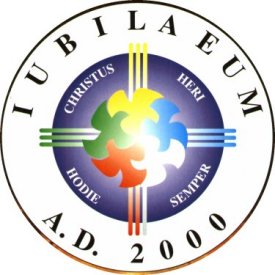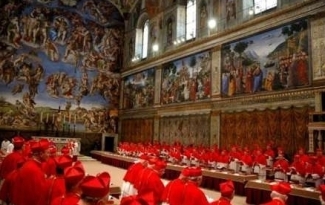This is Vocaris Media, and you are listening to Thinking with the Church. In this edition: Part 1 of a conversation with a man who has dedicated his life to studying, praying, and working to achieve Christian unity.
Andrew J. Boyd – “A.J.” to his friends – is Adjunct Professor of Theology in the Rome program of the Catholic University of America, as well as in the Rome programs of Providence College and Assumption College.
He has taught short term courses through the Lay Centre at Foyer Unitas – the Rome center founded in 1986 and dedicated to the formation of the laity and to the promotion of the lay vocation in the Church and in the world, which also works to promote Christian unity and to create opportunities for genuine encounter and sincere dialogue with people of other religions.
AJ has also worked with the sabbatical program of the Pontifical North American College.
We’d known of each other for some time before we met “in real life” at the inauguration of the KAICIID dialogue foundation in Vienna in 2015.
He is an extraordinarily thoughtful interlocutor – only, don’t let his soft-spoken demeanor fool you – he is capable of giving as good as he gets in any discussion.
Don’t take my word for it, though. Let AJ get us rolling with his take on what the ecumenical project is.
“Last Supper” by Vicente Juan Masip [Public domain], c. 1562, via Wikimedia Commons
That was Part 1 of a two-part conversation with ecumenist AJ Boyd.
We’ll bring you Part II next week.
There’s a story told among analytical philosophers – not that I traffic very much in such circles – about a theologian or divine who, one night at dinner in the college, pronounced, “The Church is One!” only to have one of his companions archly ask, “One what?”
Well, the Catholic Church has always thought – believed and taught – that there exists a single Church of Jesus Christ, which subsists in the Catholic Church, governed by the Successor of Peter and by the Bishops in communion with him (cf. Dominus Iesus 17):
Just as there is one Christ, so there exists a single body of Christ, a single Bride of Christ: “a single Catholic and apostolic Church”. Furthermore, the promises of the Lord that he would not abandon his Church (cf. Mt 16:18; 28:20) and that he would guide her by his Spirit (cf. Jn 16:13) mean, according to Catholic faith, that the unicity and the unity of the Church — like everything that belongs to the Church’s integrity — will never be lacking. (ibid.)
Indeed, one of the surprising things for me has been the discovery of how fervently Christians of other confessions also believe in the Four Marks: that the Church is indeed “One, Holy, Catholic, and Apostolic” – however different their understanding of what the marks indicate and what it means to profess them – because – I must confess – I cannot understand caring about the Marks at all and not being instantly and therefore Catholic. So this fellow, who grew up in CatholicTown, USA, and has spent almost the whole of his adult life in Rome, is on a pretty steep learning curve.
I am sure of one thing, though: it is for us, the baptized faithful of every confession and of every state of life in the Church, to live, pray, and work for the unity desired and promised by Christ Our Lord:
In treating the question of the true religion, the Fathers of the Second Vatican Council taught: “We believe that this one true religion continues to exist in the Catholic and Apostolic Church, to which the Lord Jesus entrusted the task of spreading it among all people. Thus, he said to the Apostles: ‘Go therefore and make disciples of all nations baptizing them in the name of the Father and of the Son and of the Holy Spirit, teaching them to observe all that I have commanded you’ (Mt 28: 19-20). Especially in those things that concern God and his Church, all persons are required to seek the truth, and when they come to know it, to embrace it and hold fast to it”. (Ibid., 23, DH, 1)
In all this, “The revelation of Christ will continue to be ‘the true lodestar’ in history for all humanity. (Ibid.)” Dominus Iesus – a much maligned and deeply misunderstood document, supposedly one-sided and heavy-handed, ends with an almost mystical vision taken from the Fathers of the II Vatican Council.
“The truth, which is Christ,” writes Pope St. John Paul II in his Encyclical Letter Fides et ratio, “imposes itself as an all-embracing authority.” He goes on to say:
The Christian mystery, in fact, overcomes all barriers of time and space, and accomplishes the unity of the human family: ‘From their different locations and traditions all are called in Christ to share in the unity of the family of God’s children… Jesus destroys the walls of division and creates unity in a new and unsurpassed way through our sharing in his mystery. This unity is so deep that the Church can say with Saint Paul: ‘You are no longer strangers and sojourners, but you are saints and members of the household of God’ (Eph 2:19). – Ibid.
It’s not by accident, I think, that Joseph Cardinal Ratzinger concluded his doctrinal note on the relation of the Catholic Church to other Christian Churches and ecclesial communities and other religions, with just these quotations from the then-recently-published Fides et ratio. It is as if he were recalling us to the task set for us by Peter in his first letter: to give a reason for the hope that is in us.
I’ve told the story before on this podcast, about how a friend once asked me why I am Catholic – or why, after all, I am still Catholic?
I answered:
I am Catholic because the Catholic Church is true. The Catholic Church is the One Church founded by our Divine Savior, Jesus Christ, as the vehicle by which humanity is redeemed from sin and death, and restored to friendship with God. The Church is the efficacious sign of that friendship. I am Catholic because I would be reconciled to God, and to all my fellows, and at peace with all and every one, and the Catholic Church promises this. For now, I see this through a glass, darkly, in a darkness the brightest spots of which are often but the dimmest glimmers of hope – though I am told this is a hope, which does not disappoint. Why am I Catholic? Let me answer with Peter: where else shall I go?
**********
Friends, the podcasting arm of Vocaris Media is listener-supported, so, your donations really are what makes this possible. $1 / show is what we ask – though we’re always happy to receive more.
You can make your donation by going to the blog – www.thinkingwiththechurch.wordpress.com – and click on the “support TwtC” tab in the menu at the top, or by going to www.vocarismedia.com and looking for the “donate” button in the top-right corner of the page.
You can participate in discussions by going to the blog: again, that’s at www.thinkingwiththechurch.wordpress.com and leaving your thoughts in the comboxes.
Follow us on Twitter: @TWTC_Rome
You can write me directly on the emails: the address is craltieri@vocarismedia.com
Subscribe and leave us a review on iTunes, or use the RSS feed to subscribe through your favorite podcast manager.
“Thanks!” as always to Executive Producer Ester Rita.
Our web guru is Christopher Bauer Anderson – “Topher” Anderson of www.lifesiteministries.org.
Sean Beeson composed our theme. Hear more of his musical stylings at www.seanbeeson.com.
St. Gabriel Archangel, pray for us!
Praised be Jesus Christ, now and forever!
*********** Show Notes ***********
For the Common Declaration of the Catholic Church and the Assyrian Church of the East, click here
The Assyrian Church of the East grew out of the Nestorian tradition, which affirms that Christ existed as two persons – one human and the other Divine, to which one of the exaggerated responses was Monophysitism – the idea that Christ had only one Divine nature, either because His human nature had been subsumed by His Divine nature, or because the Divine mind somehow replaced or supplied Christ’s human reason in the Incarnation.
Both Nestorianism and Monophysitism were condemned by Church Councils at Chalcedon et passim.
For more on Nestorianism, click here
For more on Monophysitism, click here
At 24:05, A.J. refers to the “Ravenna Document” – the framework agreement among the Catholic Church and several Orthodox Churches regarding – among other things – the taxis of the 1st millennium, according to which, “Rome, as the Church that ‘presides in love’ according to the phrase of St Ignatius of Antioch (To the Romans, Prologue), occupied the first place in the taxis, and that the bishop of Rome was therefore the protos among the patriarchs.”
For a brief history of the modern ecumenical movement – especially the Catholic Church’s commitment to the movement in the wake of the II Vatican Council – see the summary from the US Catholic Bishops, here
Episode 6: Ut unum sint – Part 1 of an ecumenical conversation with Prof. A.J. Boyd




 We are in the midst of an extraordinary
We are in the midst of an extraordinary





